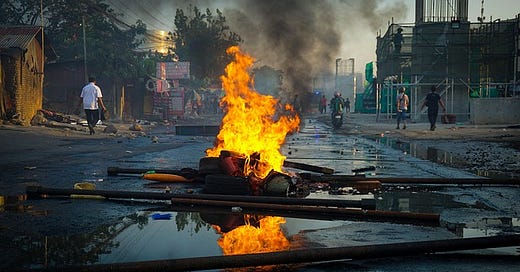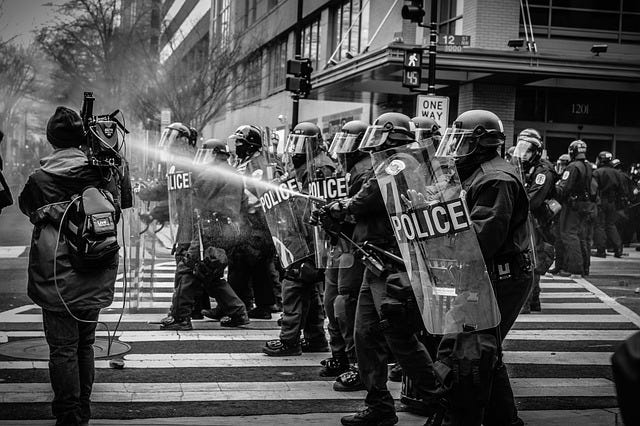Welcome to The Hot Cut—where pop culture gets sliced, scandal gets spiced, and secrets get exposed.
I’m Lisa T., and this is where satire meets scar tissue.
You didn’t hear it from me… but let’s dive in.
The Zoot Suit Blueprint
It wasn’t a war zone, but it was staged like one. In 1943, downtown Los Angeles erupted in chaos as mobs of U.S. servicemen attacked Mexican American teenagers dressed in wide-legged zoot suits. The papers called it a style revolt. The city called it a race riot. But make no mistake: this was a performance. And the real story isn’t who got beat up.
Listen to the podcast episode.
It’s who got away clean.
The LAPD didn’t rush in to protect the victims. They arrested them. The press called it an outbreak of ethnic delinquency—Mexican youth threatening the patriotic order. But what headlines leave out in stories like these is just as telling.
No one mentioned Emil Harris. And why would they?
Emil Harris was Los Angeles’ first Jewish police chief—and only the second in the city’s history. He didn’t rise up the chain. He was placed at the top. In late 1877, the Los Angeles Common Council appointed him directly to the role.
Harris first made headlines in 1874 after capturing Tiburcio Vásquez—a Mexican Californio branded either a bandit or a folk hero, depending on who you ask. Some say Vásquez was a violent outlaw. Others say he was resisting a post–Mexican-American War land grab, led by speculators who redrew the map—and the laws—in their favor.
But Emil Harris wasn’t some local hero turned lawman. He was a German immigrant who arrived just a few years earlier—known more for business than badges. His appointment wasn’t earned on the streets. It was granted from above. Imported authority. Just like the tactics that would follow more than a century later.
The social landscape was volatile. Chinese laborers, brought in for railroad construction and other menial work, were often scapegoated during periods of economic anxiety—targeted in riots and lynchings, excluded from legal protection, and treated as permanent outsiders. Yet in the official narratives of crime and order, they were rarely depicted as agents. Only threats. Only shadows.
Meanwhile, figures like Harris became heroes. He wrote the legend, and others were written over.
And yet, for all that visibility, foreign born Harris remains the only Jewish police chief in the city's history. In a city with the largest Jewish population outside of Israel second only to New York City, that absence raises a quiet but potent question: why has there never been another?
Special Guest Cameos
They played mayor. They played chief. But never got a series order.
It’s worth noting that Emil Harris briefly served as acting mayor of Los Angeles in 1878, stepping in after the elected mayor died in office. Later that same year, another Jewish figure—Bernard Cohn—also held the mayoral seat for just two weeks. And then, nothing.
No elected Jewish mayor until Eric Garcetti in 2013—more than 130 years later. The pattern isn’t just visibility. It’s appointment, then erasure.
In a city where Jewish success shaped media, real estate, and medicine, that silence says more than any headline ever could.
The pattern had been set.
By the time of the Zoot Suit riots, the LAPD had long been trained to see ethnic pride demonstrated in certain groups as a threat to order. And when that threat flared up, the same story was reprinted with new names. This time, there were no outlaw legends, only working-class brown boys in baggy pants. And again, the people who lit the match remained offstage.
Pattern Recognition
The Race Riot Cycle
If you want to understand Los Angeles, don’t just look at its history. Look at its reruns.
1965 – Watts. Police brutality sparks protest. Governor delays the National Guard.
1992 – Rodney King. A camcorder catches the beating, a jury returns not guilty, and the city explodes while the world watches from their televisions.
1995 – O.J. Simpson. The trial isn’t about guilt. It’s about spectacle. The supporting cast includes a Nazi memorabilia–collecting detective named Mark Fuhrman—cartoonish irony, or perfectly cast villain? It becomes a national reality show on race often dubbed “the trial of the century.”
2020 – George Floyd. The protests are global. But in Los Angeles, the choreography is familiar: celebrity sound bites, boarded-up stores, viral videos of both peace and chaos.
Each time, there’s a wound. Each time, there’s a flame. And each time, the media is somehow always camera ready before the smoke clears.
The Ethnic Chessboard
Who’s Framed, Who’s Invisible
In these civic passion plays, the roles are typecast:
Black and brown bodies are pushed to center stage—to march, mourn, or burn. White aggressors, when visible, are allowed to be disavowed, punished, or problematized. But one role is never acknowledged, even though it keeps showing up in the credits: the off-screen director.
It’s not just about race. It’s about edit privilege. There are groups who are never assigned the role of oppressor or oppressed. They remain just outside the camera frame—positioned behind the mic, shaping the message, writing the next act.
Sometimes, invisibility isn’t marginalization. It’s power.
From Jerusalem to Jefferson Blvd
Imported tactics, exported tension.
In 2002, LAPD officers began participating in training exchanges with Israeli police and military forces under programs like JINSA’s Law Enforcement Exchange Program. These trips—justified as counterterrorism collaborations—brought back tactics developed in occupied zones and applied them in LA’s urban neighborhoods.
Under Chief Bill Bratton, these exchanges expanded. Surveillance tech, crowd control strategies, and behavioral profiling tools designed for warfare made their way into local policing.
The optics? LA was “learning from experience.”
The reality? LA was importing occupation.It makes you wonder—if the police don’t reflect the neighborhoods they serve, and the tactics don’t originate here either… who, exactly, is being protected?
Aftermath Economics
Follow the Money
After Watts: new highways, displaced communities. After Rodney King: LAPD budgets explode, surveillance programs begin. After BLM: mural grants, DEI rollouts, nonprofit booms—and private donations to the LAPD to fund robotic police dogs. No structural change. Just a hotter real estate market.
The pain is public. The profit is private.
Playing The Blame Game
The same neighborhoods burn. The same communities get labeled angry. The same frontline chaos gets televised.
But the land developers never get blamed. The media executives never get blamed. The city planners, the legacy institutions, the editorial boards—always blameless, always watching.
When people scream about white supremacy, it often gets pinned on poor white rage. That’s convenient. It leaves untouched the institutions that actually benefit from racial tension—institutions rarely run by the working-class white people being publicly shamed.
It begs the question: Are we in need of an update of the criteria we’re using to define privilege? Perhaps the greatest privilege of all is the ability to invoke silence.
Closing Cut
The Stage Is Shifting
Hollywood is losing its grip. The entertainment industry, long the global supplier of narrative and emotion, is no longer centralized. Studios are downsizing. Networks are consolidating.
We make our own content now. We follow different feeds. We cut our own reels.
Perhaps that means the City of Angels won’t be able to host the next riot edit. Maybe its ritual function is finally growing obsolete.
If this city was the stage where America historically performed its most high-profile racial drama, it might be time to bring the curtain down.
Because the next time they burn it for the cameras, we might not flinch.
And what sound does a race riot make without an audience?
If we look past the smoke this time, we might see the real fire—the one they’re trying to light elsewhere.
And when the consent isn’t manufactured fast enough, they’ll strike the match again. Until we finally put it out.
Further Reading & Receipts
Welcome to the paper trail.
Some links may go missing—whether from takedowns, time, or targeted memory-holing. If you catch a broken one, leave a comment or shoot me a message. We’re building this archive in real time.
Many of the sources and backups are being preserved in The Vault, an exclusive archive for paid subscribers.
Zoot Suit Riots
History.com – “Zoot Suit Riots: Causes, Facts & Photos”
A solid overview of how the 1943 Los Angeles Zoot Suit Riots unfolded, including arrests, bans, and broader context.
🔗 https://www.history.com/articles/zoot-suit-riots en.wikipedia.org+12history.com+12britannica.com+12teachrock.org+7digitalcommons.chapman.edu+7en.wikipedia.org+7Britannica – “Zoot Suit Riots | Summary, Causes, Significance, & Facts”
Offers key dates (June 3–10, 1943), the Sleepy Lagoon connection, and the racial and cultural backdrop.
🔗 https://www.britannica.com/event/Zoot-Suit-Riots en.wikipedia.org+8britannica.com+8en.wikipedia.org+8National WWII Museum – “The Zoot Suit Riots and Wartime Los Angeles”
Deeper dive into perspectives of activists like George I. Sanchez and societal conditions in wartime LA.
🔗 https://www.nationalww2museum.org/war/articles/zoot-suit-riots-and-wartime-los-angeles nypost.com+15nationalww2museum.org+15en.wikipedia.org+15Chapman University – “Threads of the Zoot Suit Riots” (Antonio Franco)
Scholarly paper dissecting the riot's origins, including blame from various societal groups.
🔗 https://digitalcommons.chapman.edu/vocesnovae/vol10/iss1/4/ digitalcommons.chapman.eduOpenSpaces – “Racial Media Framing of Riots and Protests: A Constructionist View”
A well-regarded academic study on how media frames minority unrest and its societal implications.
🔗 https://openspaces.unk.edu/undergraduate-research-journal/vol22/iss1/10 teenvogue.com+15openspaces.unk.edu+15journals.sagepub.com+15
🐴 Tiburcio Vásquez
Wikipedia – “Tiburcio Vásquez”
A comprehensive biography of the famous Californio bandit (1835–1875), his social context, crimes, and legacy.
https://en.wikipedia.org/wiki/Tiburcio_V%C3%A1squez latimes.com+11en.wikipedia.org+11lancastermoah.org+11hometownstation.com+2lancastermoah.org+2topanganewtimes.com+2California Frontier – “Tiburcio Vásquez and Vaquero Vengeance”
Explores his lineage from the De Anza expedition and ties to Californios resisting Anglo-American dominance.
https://www.californiafrontier.net/tiburcio-vaquez-and-vaquero-vengeance/ legendsofamerica.com+2californiafrontier.net+2en.wikipedia.org+2Legends of America – “Tiburcio Vásquez – California Desperado”
Details early life in Monterey, ranch heritage, bilingual education, outlaw life, and eventual capture.
https://www.legendsofamerica.com/we-tiburciovasquez/ scvhistory.com+10legendsofamerica.com+10en.wikipedia.org+10
👮 Emil Harris
Wikipedia – “Emil Harris”
Profile of Prussian-born Emil Harris (1839–1921), who served as LA’s first Jewish police chief from 1877 to 1878.
https://en.wikipedia.org/wiki/Emil_Harris thesis.library.caltech.edu+4en.wikipedia.org+4web-app.usc.edu+4
🏙 Chinese Massacre & Anti-Chinese Climate
Wikipedia – “Los Angeles Chinese massacre of 1871”
Full account of the October 24, 1871 massacre—500-person mob lynching 19 Chinese immigrants on Calle de los Negros.
https://en.wikipedia.org/wiki/Los_Angeles_Chinese_massacre_of_1871 en.wikipedia.org+12en.wikipedia.org+12cschs.org+12California Legal History PDF – “The Los Angeles Chinese Massacre of 1871 at Trial” (Paul R. Spitzzeri)
Detailed legal history, including Constable Emil Harris’s role as a witness in the inquest.
https://www.cschs.org/wp-content/uploads/2022/01/Legal-Hist-v.3-Chinese-Massacre-full-text-c.pdf web-app.usc.edu+2cschs.org+2en.wikipedia.org+2eScholarship – “Revisioning the History and Future of US Policing”
Contextualizes anti-Chinese violence across California and ties it to labor unrest and formal exclusion laws.
https://escholarship.org/content/qt0864g7vw/qt0864g7vw_noSplash_20e5f19b044bd734fbbd4505c015ae20.pdf escholarship.org+1en.wikipedia.org+1
Want More Uncomfortable Questions?
This has been The Hot Cut—spicy dives, sharp truths.
For the deeper wounds beneath pop culture, check out The Hidden Cut.
For biblical breadcrumbs and forgotten edits, go to The Deeper Read.
🔪 Stay sharp. Stay curious.
Subscribe to Lisa Writes Now for all the cuts that matter.
🎬 Continue the Series
← Previous Episode: Netflix & Kill
→ Next Episode: Entrapment State
📂 Full Episode Guide: Cold Open
Think something got left on the cutting room floor?
Add your notes below—we’re still editing in real time.







